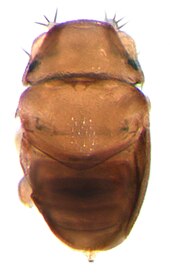Euryplatea eidmanni
| Euryplatea eidmanni | ||||||||||||
|---|---|---|---|---|---|---|---|---|---|---|---|---|
| Systematics | ||||||||||||
|
||||||||||||
| Scientific name | ||||||||||||
| Euryplatea eidmanni | ||||||||||||
| Schmitz , 1941 |
Euryplatea eidmanni is a fly art from the family of the humpbacked flies (Phoridae). The approximately 1.1 mm long blackish females of the species have hardly any bristles, are compact and have small eyes and short, wide wings. The males of the species are so far unknown. Euryplatea eidmanni lives on the Equatorial Guinean island of Bioko off the west coast of Africa. There it is attacked by the ant species Crematogaster impressa , in whose head it lays its eggs. Euryplatea eidmanni was first described by Hermann Schmitz in 1941. Besides Euryplatea nanaknihali, thespecies isthe only representative of the genus Euryplatea .
features
So far only females of Euryplatea eidmanni have been described. They are about 1.1 mm long and blackish in color. The head is about 0.2 mm long, semicircular when viewed from above and completely black on the top. At the base it is widest at around 0.5 mm. Its surface is finely hairy. The black eyes are very small, hardly protrude and are on the top of the head. They are egg-shaped and touch the front of the antennae. Each eye has around 150 ommatidia with a maximum size of 0.125 × 0.175 mm . The ocelli lie on the edge of the head and are only rudimentary. The antennae are sharply delimited and deepened, only the third antenna segment protrudes from them. The downy antennae bristles are around 1.5 times as long as the third antennae, stiff and light in color. The buttons are small and flattened, they have about six bristles. The trunk of E. eidmanni is small and whitish gray, it is retracted into the oral cavity. The 0.6 mm wide and 0.2 mm long thorax has only four bristles. It is black, less shiny than the forehead, but just as finely haired. The wide label ( scutellum ) measures around 0.4 × 0.1 mm. The metanotum is short, wide and covered, it only protrudes slightly into the abdomen. The abdomen is narrower at the base than the thorax. The first tergite is shortened, the second slightly elongated, while the third and fourth lie between the two in length. The fifth tergite is triangular and the longest of all. All tergites are very sparsely hairy. Since they become narrower towards the rear, the abdomen protrudes from the third tergite below them. The seventh segment has a small, rounded dorsal plate and, like the eighth segment, is hairless. The ninth and tenth segments are extremely small; the same applies to the short hairy cerci .
The legs of the species are short and sturdy. They are brown in color, with the tarsi a little lighter. The fore leg is about 0.30 mm long and, like all other femora, has a pit into which the 0.17 mm long front splint can be sunk. The front tarsi are short and stocky and nearly as long as the rails. The middle femur is 0.30 mm long and the posterior femur 0.37 mm long. The middle rail measures 0.22 mm while the rear rail is 0.26 mm. Palisades can only be found on the tarsi. The hind tarsi measure around 0.36 mm.
The wings are short and relatively wide. The Costa loader has short eyelashes. The third longitudinal artery is not forked and wider than the Costa loader. Costa vein, subcostal vein and third longitudinal vein are brownish, the remaining veins are clearly reduced and can only be seen very indistinctly.
distribution
Euryplatea eidmanni has so far only been found on the island of Bioko in Equatorial Guinea in the Gulf of Guinea . It is unclear whether it occurs in the rest of the distribution area of its host Crematogaster impressa .
Way of life
Euryplatea eidmanni lives myrmecophil . The species is probably a parasitoid of C. impressa workers. The fly may lay its eggs in the ants' heads, as is usual with humpback flies , where the larvae hatch and feed on the tissue of the head capsule. The ants' head eventually falls off through enzyme production and the larvae pupate inside.
Systematics and taxonomy

Euryplatea eidmanni was first described by Hermann Schmitz in 1941 . He had received the necessary specimens of the species from Hermann August Eidmann , who had collected them during an expedition to Bioko in 1939/40. Schmitz placed it in its own genus Euryplatea and dedicated the specific epithet to Eidmann. The closest related species is the around two thirds smaller E. nanaknihali from Thailand . How the large geographic gap between the two species can be explained in terms of evolution is still unclear.
swell
literature
- Brian V. Brown: Small Size No Protection for Acrobat Ants: World's Smallest Fly Is a Parasitic Phorid (Diptera: Phoridae). In: Annals of the Entomological Society of America 105 (4), 2012. doi : 10.1603 / an12011 , pp. 550-554.
- Hermann Schmitz: A new genus of genus from West Africa. In: Natuurhistorisch Maandblad 30, 1941. pp. 77-80.